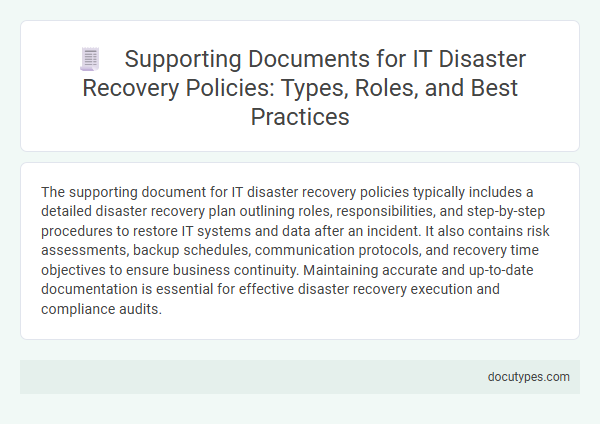The supporting document for IT disaster recovery policies typically includes a detailed disaster recovery plan outlining roles, responsibilities, and step-by-step procedures to restore IT systems and data after an incident. It also contains risk assessments, backup schedules, communication protocols, and recovery time objectives to ensure business continuity. Maintaining accurate and up-to-date documentation is essential for effective disaster recovery execution and compliance audits.
Introduction to Supporting Documents in IT Disaster Recovery
Supporting documents for IT disaster recovery policies provide essential guidelines and detailed procedures to restore IT systems after disruptions. These documents ensure clarity, accountability, and effective execution of disaster recovery plans.
- Purpose and Scope - Defines the objectives and extent of the disaster recovery efforts covered by the policy.
- Roles and Responsibilities - Outlines specific duties assigned to IT staff and management during recovery operations.
- Recovery Procedures - Details step-by-step actions required to recover critical systems and data efficiently.
Importance of Supporting Documents for Policy Implementation
| Topic | Details |
|---|---|
| Supporting Document for IT Disaster Recovery Policies | Supporting documents for IT disaster recovery policies include recovery plans, risk assessments, backup procedures, and communication protocols. These documents provide detailed guidelines and actionable steps to restore IT systems after an unexpected event. |
| Importance of Supporting Documents | Supporting documents are essential for effective policy implementation. They offer clarity on roles, responsibilities, and timelines, reducing ambiguity during a crisis. These documents ensure consistency in recovery efforts and facilitate quick decision-making by IT teams. |
| Benefit for Policy Implementation | With well-prepared supporting documents, your organization can maintain operational continuity and safeguard critical data. Clear documentation enhances training, compliance, and audit processes by providing evidence of preparedness and risk management. |
Common Types of Supporting Documents in IT DR Policies
Supporting documents for IT Disaster Recovery (DR) policies provide critical evidence and detailed information to ensure effective implementation and compliance. These documents outline procedures, roles, and technical details essential for recovering IT systems after disruptions.
- Business Impact Analysis (BIA) - Identifies critical IT assets and quantifies the potential impact of disruptions to prioritize recovery efforts.
- Disaster Recovery Plan (DRP) - Detailed, step-by-step procedures for restoring IT services and infrastructure following a disaster event.
- Backup and Restore Procedures - Documentation of data backup schedules, methods, storage locations, and restoration processes to safeguard information integrity.
Role of Supporting Documents in Compliance and Audit
What is the supporting document for IT disaster recovery policies? Supporting documents provide detailed evidence and guidelines that ensure the disaster recovery plan is implemented correctly. These documents play a crucial role in demonstrating compliance with regulatory standards during audits.
Checklist: Essential Supporting Documents for IT Disaster Recovery
Supporting documents for IT disaster recovery policies provide the necessary framework and evidence to ensure effective response in case of IT disruptions. These documents verify compliance, guide recovery processes, and support risk assessment strategies.
A checklist for essential supporting documents includes the IT disaster recovery plan, system inventory, and data backup schedules. Other critical documents are risk assessment reports, recovery team contact lists, and communication plans for incident management.
Best Practices for Creating and Maintaining Supporting Documents
Supporting documents for IT disaster recovery policies provide detailed procedures, roles, and resources essential for effective incident management. These documents ensure clarity and consistency during disaster recovery efforts.
- Comprehensive Incident Response Plans - Outline specific steps and responsibilities to restore IT operations promptly after a disaster.
- Asset and Resource Inventories - Maintain updated lists of hardware, software, and critical data to facilitate quick recovery processes.
- Regular Review and Testing Schedules - Establish timelines for periodic evaluation and drills to validate the relevance and effectiveness of recovery procedures.
Creating and maintaining detailed, accurate supporting documents enhances the resilience and preparedness of IT disaster recovery strategies.
Version Control and Document Management Strategies
The supporting document for IT Disaster Recovery Policies outlines essential version control and document management strategies to ensure accuracy and accessibility. Version control tracks changes systematically, preventing errors and maintaining a comprehensive history of policy updates. Your IT team must implement robust document management practices to organize, store, and retrieve these policies efficiently during critical recovery scenarios.
Integrating Supporting Documents with IT DR Plans
Supporting documents for IT Disaster Recovery (DR) policies are essential records that provide detailed guidelines, procedures, and evidence to ensure effective disaster response and recovery. These documents include risk assessments, business impact analyses, recovery strategies, and communication plans that align with the organization's IT DR objectives.
Integrating supporting documents with IT DR plans enhances clarity and operational readiness by creating a centralized resource for IT teams during a disaster. This integration allows for seamless coordination between technical recovery actions and organizational policies. Maintaining updated supporting documents ensures that recovery efforts reflect current infrastructure, compliance requirements, and emerging threats.
Common Challenges in Documenting IT Disaster Recovery Policies
The supporting document for IT disaster recovery policies serves as a detailed guide outlining procedures, roles, and resources required to restore IT systems after a disruption. This document ensures clarity and preparedness in the event of a disaster.
Common challenges in documenting IT disaster recovery policies include capturing all critical infrastructure components and keeping the documentation up to date with evolving technology. You may also face difficulties in coordinating input from multiple departments to create comprehensive and actionable policies.
What Is the Supporting Document for IT Disaster Recovery Policies? Infographic

